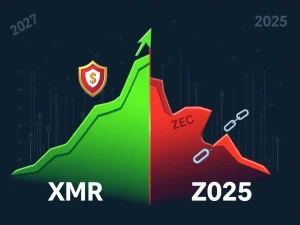Ethereum: Shockwave as Whales Trigger $1.7 Billion ETH Withdrawal from Aave, Sending Borrowing Rates Soaring 10%

The world of decentralized finance (DeFi) just experienced a significant tremor. In a move that sent ripples across the market, prominent crypto whales have initiated a staggering $1.7 billion Ethereum (ETH) withdrawal from the Aave lending protocol. This massive outflow has not only sparked market volatility but also pushed borrowing rates on the platform up by a dramatic 10%. What does this mean for Aave, Ethereum, and the broader DeFi ecosystem? Let’s dive in.
The Great Ethereum Exodus: What Just Happened?
Over the past seven days, the DeFi landscape has been captivated by a series of large-scale Ethereum withdrawals from Aave, one of the largest decentralized lending platforms. These withdrawals, totaling approximately $1.7 billion, were executed by significant players in the digital asset space, often referred to as ‘whales’ due to their substantial holdings and market influence.
The immediate consequence of this rapid liquidity drain was a sharp increase in Aave’s borrowing rates, particularly for ETH. When a large amount of an asset is withdrawn from a lending pool, the supply available for borrowing decreases. If demand remains constant or increases, the cost of borrowing – the interest rate – naturally rises. This is precisely what transpired, leading to a 10% surge in borrowing costs.
Aave Under Pressure: Navigating the Liquidity Shift
While the headlines might suggest panic, it’s crucial to understand the nuances of the situation for Aave. The protocol, which boasts over $55 billion in total deposits, is designed with mechanisms to handle such large movements, though temporary disruptions are inevitable.
Here’s a breakdown of the immediate impact on Aave:
- Reduced Liquidity: The primary effect is a temporary reduction in the available ETH liquidity within Aave’s pools. This makes it harder for new borrowers to access funds at previous rates.
- Spiked Borrowing Rates: As mentioned, the most visible impact is the significant increase in borrowing rates. This directly affects those who have borrowed ETH from Aave, as their interest payments become higher.
- Staking Backlog: A notable challenge is the 627,944 ETH currently stuck in a staking backlog. This bottleneck could take up to 11 days to resolve, compounding the short-term liquidity challenges and potentially affecting the overall user experience.
Despite these challenges, Aave’s overall liquidity remains robust when compared to the broader market conditions, indicating the platform’s underlying strength and design resilience.
Who Are These Crypto Whales and What’s Their Play?
The architects behind this colossal Ethereum withdrawal include some of the most prominent names in the crypto space. The movements are attributed to institutional and high-net-worth participants, with specific attention drawn to:
- Justin Sun: The founder of Tron, Justin Sun, was a key player, withdrawing a staggering $646 million in ETH over a three-day period. While this fueled initial speculation about a complete exit, his remaining $80 million in Aave deposits suggest a more strategic, partial withdrawal rather than a full abandonment.
- HTX: The crypto exchange HTX, where Justin Sun previously advised, also transferred $455 million in ETH during the same timeframe.
- Abraxas Capital: This entity contributed significantly to the trend, withdrawing $115 million, further exacerbating the liquidity constraints.
The motivations behind such large withdrawals can be varied. They might include rebalancing portfolios, preparing for new investment opportunities, seeking higher yields elsewhere, or simply de-risking positions in a volatile market. Their actions, however, undeniably highlight the influential role of crypto whales in shaping market sentiment and liquidity dynamics within DeFi ecosystems.
The Ripple Effect: Understanding Surging Borrowing Rates
The dramatic 10% increase in borrowing rates on Aave has immediate and far-reaching consequences for users and the broader DeFi landscape. For many yield-generating strategies that rely on borrowing at low rates to leverage other opportunities, this spike has been a significant disruption. It makes such strategies less profitable or even unprofitable, prompting further outflows as participants seek more favorable conditions elsewhere.
Conversely, some lenders on Aave have benefited from this surge. Higher borrowing rates mean higher interest earnings for those providing liquidity to the protocol. This dynamic underscores the ever-shifting landscape of DeFi, where market conditions can rapidly turn a disadvantage for one party into an advantage for another.
Decoding the DeFi Domino Effect: Beyond Aave’s Rates
Despite the recent turbulence experienced by Aave, the broader trends within the DeFi sector remain largely positive. This year, DeFi protocols have seen net inflows, driven primarily by growing institutional interest and the robust performance of Bitcoin. This suggests that while individual protocol events can cause localized volatility, the underlying growth narrative for decentralized finance remains strong.
Neli Zaltsman, JPMorgan’s head of Blockchain Payments, recently commented on the increasing convergence between DeFi and traditional finance (TradFi). Institutions are actively prioritizing blockchain integration, albeit within established regulatory frameworks. “Our goal has always been to find the best way to work with the public blockchain, regulatory environment permitting,” Zaltsman emphasized, reflecting a cautious yet optimistic approach from traditional financial giants.
This incident with Aave serves as a powerful reminder of the interconnectedness of crypto markets. Large-scale movements by crypto whales can quickly impact liquidity, pricing, and investor confidence across multiple platforms. It also underscores the critical need for robust risk management strategies within decentralized platforms to ensure their long-term stability and resilience against sudden shifts in market dynamics.
Conclusion: Navigating the Tides of DeFi
The recent $1.7 billion Ethereum withdrawal from Aave by influential crypto whales has undoubtedly created a stir, pushing borrowing rates higher and highlighting liquidity sensitivities within the DeFi ecosystem. While Aave faces short-term challenges, its fundamental architecture and substantial deposits suggest a capacity for resilience.
This event is a stark illustration of the power of large holders in a decentralized world. It also reinforces the ongoing evolution of DeFi, where institutional players are increasingly looking to integrate, bringing both capital and the need for regulatory clarity. As the market continues to mature, understanding these whale movements and their ripple effects will be crucial for participants looking to navigate the dynamic and often exhilarating tides of decentralized finance.
Frequently Asked Questions (FAQs)
1. What triggered the recent surge in Aave’s borrowing rates?
The primary trigger was a massive $1.7 billion Ethereum (ETH) withdrawal from the Aave lending protocol by several prominent digital asset whales. This significant reduction in available ETH supply within Aave’s pools, coupled with continued demand, caused the cost of borrowing to increase sharply by 10%.
2. Who are the main “crypto whales” involved in the Aave withdrawals?
Key figures identified in the large-scale withdrawals include Justin Sun, the founder of Tron, who withdrew $646 million in ETH, and the crypto exchange HTX, which transferred $455 million. Additionally, Abraxas Capital contributed to the trend with a $115 million withdrawal.
3. How has this affected Aave’s liquidity and operations?
The withdrawals have led to reduced ETH liquidity within Aave’s pools and a significant spike in borrowing rates. There’s also a backlog of 627,944 ETH in staking that could take up to 11 days to resolve, posing short-term operational challenges. However, Aave’s overall liquidity remains robust compared to broader market conditions.
4. What does this event signify for the broader DeFi market?
This incident highlights the influential role of crypto whales in shaping market sentiment and liquidity within DeFi ecosystems. While it caused localized turbulence, the broader DeFi sector continues to see net inflows, driven by institutional interest and Bitcoin’s rally, suggesting underlying strength and growth despite such volatile events.
5. Is Aave still a safe platform for lending and borrowing?
Aave is a well-established and robust DeFi protocol. While large withdrawals can cause temporary volatility and rate spikes, the platform is designed to manage such events. Its substantial total deposits and resilience mechanisms suggest it remains a viable platform, though users should always be aware of market dynamics and potential rate fluctuations.










